In the realm of avian enchantment, birds with long tails capture our attention with their graceful and flowing plumage. These remarkable creatures take flight, trailing their elongated tails behind them like elegant banners, painting the sky with beauty and grace. From the magnificent Asian Paradise Flycatcher, with its flowing streamers, to the Peacock, showcasing its resplendent fan-shaped tail, these avian marvels demonstrate the artistry of evolution. Join us as we delve into the captivating world of birds with long tails, where their remarkable feature takes center stage and leaves us in awe of their aerial prowess. Prepare to be mesmerized as we unravel the secrets behind their stunning adaptations and witness the breathtaking display of nature’s ingenuity.
List of Birds with Long Tails
Long-tailed Widowbirds:

Image Source
- Scientific name: Euplectes progne
- Lifespan: 3-5 years
- Size: 15-20 centimeters (6-8 inches)
- Origin: Sub-Saharan Africa
Long-tailed Widowbirds (Euplectes progne) are small passerine birds found in Africa. As their name suggests, they are characterized by their exceptionally long and elegant tails. The males, in particular, possess impressive tail feathers that extend well beyond their body length. These elongated tails are black and, during the breeding season, the males display them in elaborate courtship displays to attract females. The purpose of the long tail is to enhance its visual appeal and reproductive success. In contrast, the females have shorter tails and are more inconspicuously colored. Long-tailed Widowbirds are typically found in grasslands and savannahs, where they forage for seeds and insects.
Ribbon-tailed Astrapia:
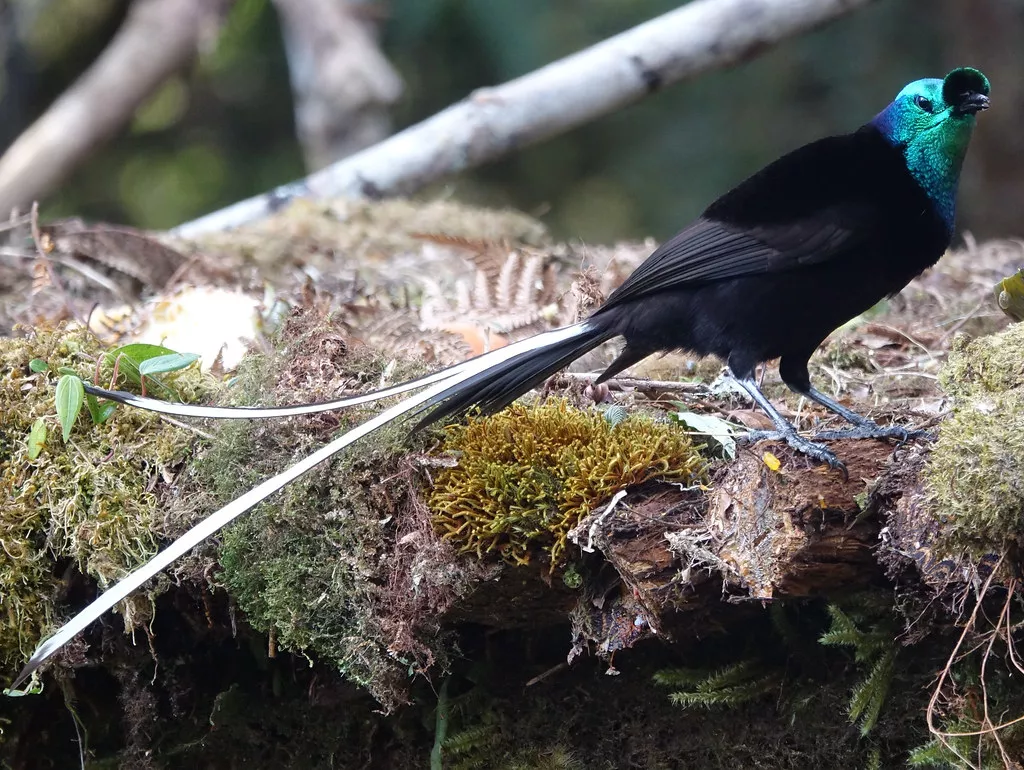
Image Source
- Scientific name: Astrapia mayeri
- Lifespan: 10-15 years
- Size: 42-50 centimeters (16-20 inches)
- Origin: Papua New Guinea
The Ribbon-tailed Astrapia (Astrapia mayeri) is a bird of paradise species native to the mountains of Papua New Guinea. This striking bird is known for its remarkable long tail, which can reach up to three times the length of its body. The male Ribbon-tailed Astrapia has glossy black plumage with iridescent blue-green highlights, while the female has more muted colors. The purpose of its extravagant tail is to attract mates during courtship displays. The long, ribbon-like tail feathers are adorned with unique patterns and can be maneuvered skillfully by the male during elaborate dances. The Ribbon-tailed Astrapia inhabits high-altitude forests and feeds on fruits, insects, and small vertebrates.
Wilson’s Bird of Paradise

Image Source
- Scientific name: Cicinnurus respublica
- Lifespan: 5-8 years
- Size: 15-18 centimeters (6-7 inches)
- Origin: Indonesia
Wilson’s Bird of Paradise (Cicinnurus respublica) is a stunning bird species found in the forests of Papua New Guinea. The male Wilson’s Bird of Paradise is known for its incredibly long and elaborate tail feathers. The tail is adorned with vibrant colors, including deep blues, greens, and browns, along with intricate patterns. During courtship displays, the male fans out his long tail feathers and performs intricate dances to attract females. The female, on the other hand, has more subdued plumage and lacks the extravagant tail feathers. Wilson’s Bird of Paradise inhabits the understory of lowland rainforests and feeds mainly on fruits and insects.
Greater Bird of Paradise:

Image Source
- Scientific name: Paradisaea apoda
- Lifespan: 5-8 years
- Size: 33-43 centimeters (13-17 inches)
- Origin: New Guinea and surrounding islands
The Greater Bird of Paradise (Paradisaea apoda) is a remarkable bird species native to the rainforests of New Guinea and surrounding islands. This species is renowned for its long and intricate tail feathers, which play a vital role in courtship displays. The male Greater Bird of Paradise has elongated, wire-like tail feathers that cascade down, creating an extravagant display during mating rituals. These feathers are richly colored, with hues of yellow, green, and brown. The female, in contrast, has more subdued plumage with shorter tails. Greater Bird of Paradise inhabits the forest canopy and feeds on fruits, insects, and small vertebrates. Its long tail feathers are a remarkable adaptation for attracting mates and ensuring reproductive success.
Red-billed Streamertail:
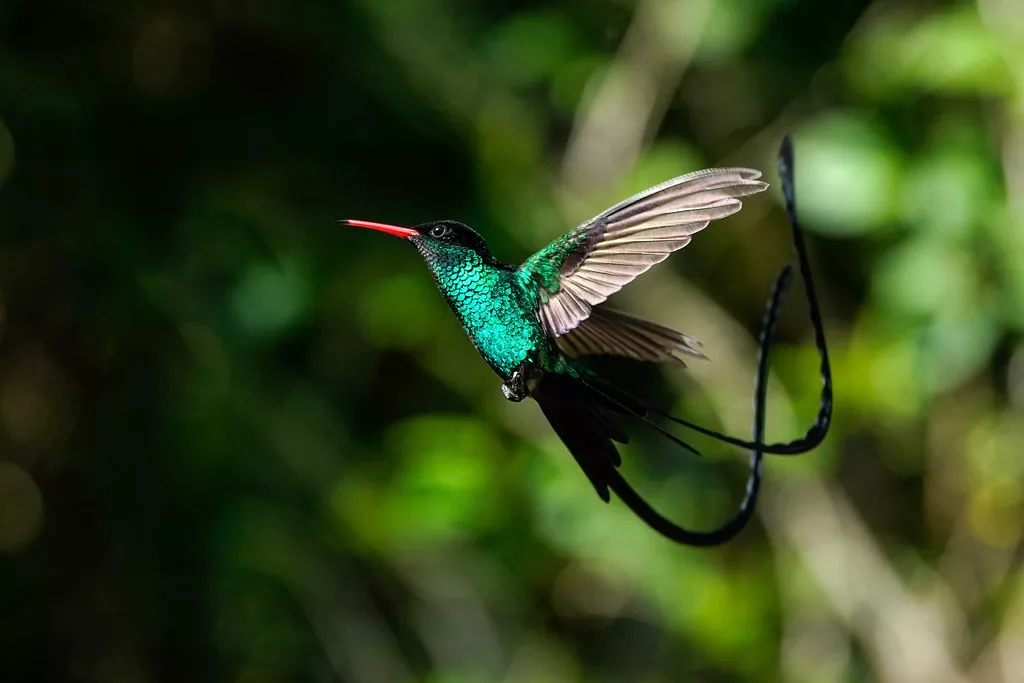
Image Source
- Scientific name: Trochilus polytmus
- Lifespan: 6-8 years
- Size: 10-11 centimeters (4-4.3 inches)
- Origin: Jamaica
The Red-billed Streamertail (Trochilus polytmus) is a species of hummingbird endemic to Jamaica. It is renowned for its long and flowing tail feathers, which give it a distinctive and graceful appearance. The male Red-billed Streamertail has elongated central tail feathers that extend well beyond its body length. These feathers are iridescent and shimmer with vibrant colors, including shades of green, blue, and black. During courtship displays, the male performs impressive aerial maneuvers, showcasing its long tail feathers to attract females. The female, on the other hand, has a shorter tail and more muted plumage. Red-billed Streamertails primarily feed on nectar from flowers and play a crucial role in pollination.
Lady Amherst’s Pheasant:
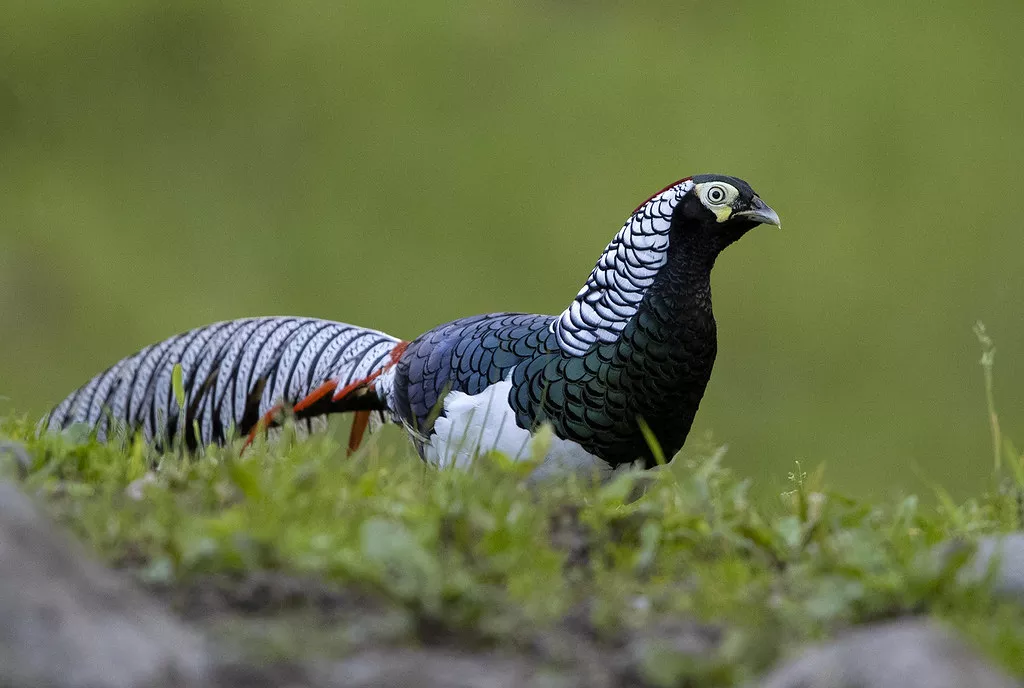
Image Source
- Scientific name: Chrysolophus amherstiae
- Lifespan: 5-10 years
- Size: 100-120 centimeters (39-47 inches)
- Origin: China and Myanmar
Lady Amherst’s Pheasant (Chrysolophus amherstiae) is a striking bird species native to southwestern China and Myanmar. This pheasant is known for its long and elegant tail feathers, which contribute to its majestic appearance. The male Lady Amherst’s Pheasant has a vibrant plumage, with a long, sweeping tail that features iridescent hues of green, blue, and gold. These impressive tail feathers are often displayed in courtship rituals to attract females. In contrast, the female has more subdued colors and shorter tail feathers. Lady Amherst’s Pheasants inhabit dense forests and feed on a variety of plant matter, seeds, insects, and small vertebrates. The long tail feathers of the male add to its beauty and make it a captivating sight in its natural habitat.
Superb Lyrebird

Image Source
- Scientific name: Menura novaehollandiae
- Lifespan: 15-20 years
- Size: 80-100 centimeters (31-39 inches)
- Origin: Australia
The Superb Lyrebird, found in Australia, is a fascinating bird known for its remarkable vocal abilities. The male lyrebird is particularly famous for its ability to mimic a wide range of sounds, including the calls of other bird species, human speech, and even sounds of mechanical origin like camera shutters and car alarms. Its impressive mimicry skills have earned it the reputation of being one of the best songsters in the avian world. In addition to its vocal talents, the Superb Lyrebird also possesses a beautiful tail that resembles a lyre, from which its name is derived. This long and elaborate tail is displayed during courtship to attract mates.
Asian Paradise Flycatcher
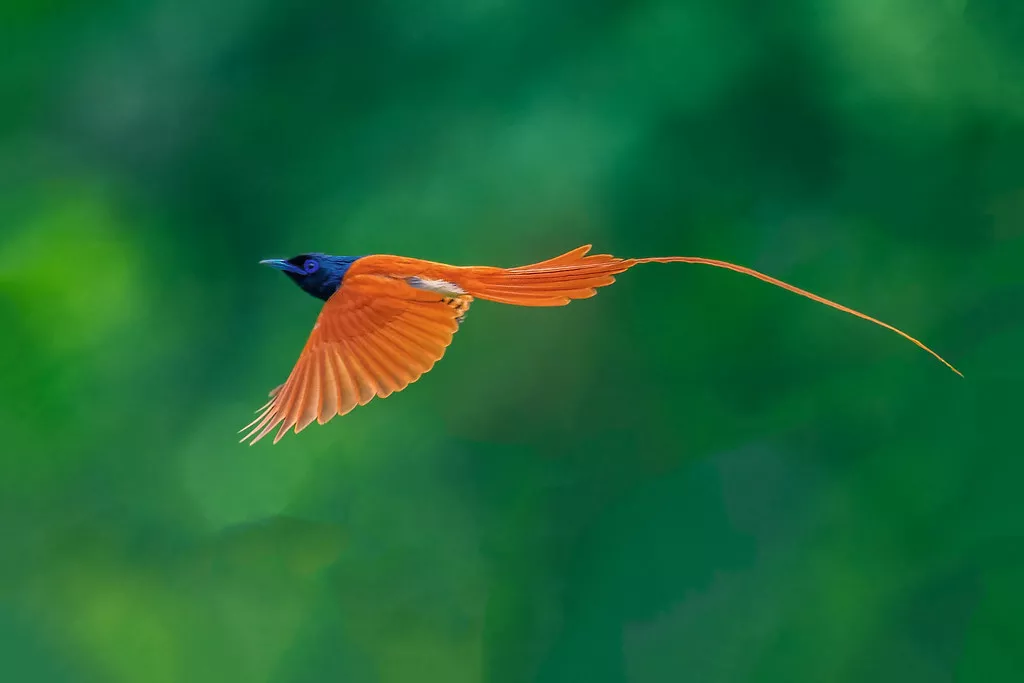
Image Source
- Scientific name: Terpsiphone paradisi
- Lifespan: 5-8 years
- Size: 17-19 centimeters (7-8 inches)
- Origin: Asia
The Asian Paradise Flycatcher is a stunning bird found in various parts of Asia, including India, Southeast Asia, and parts of China. It is renowned for its elegant appearance, with long tail feathers that can extend up to twice its body length. The male Asian Paradise Flycatcher has predominantly white plumage with elongated central tail feathers, while the female has a brownish or rufous coloration. During courtship displays, the male performs aerial acrobatics, spreading its tail feathers and fluttering around to attract the female’s attention. It primarily feeds on insects, catching them in mid-air with swift and precise movements. The Asian Paradise Flycatcher is a true symbol of beauty and grace in the avian world.
Resplendent Quetzal:
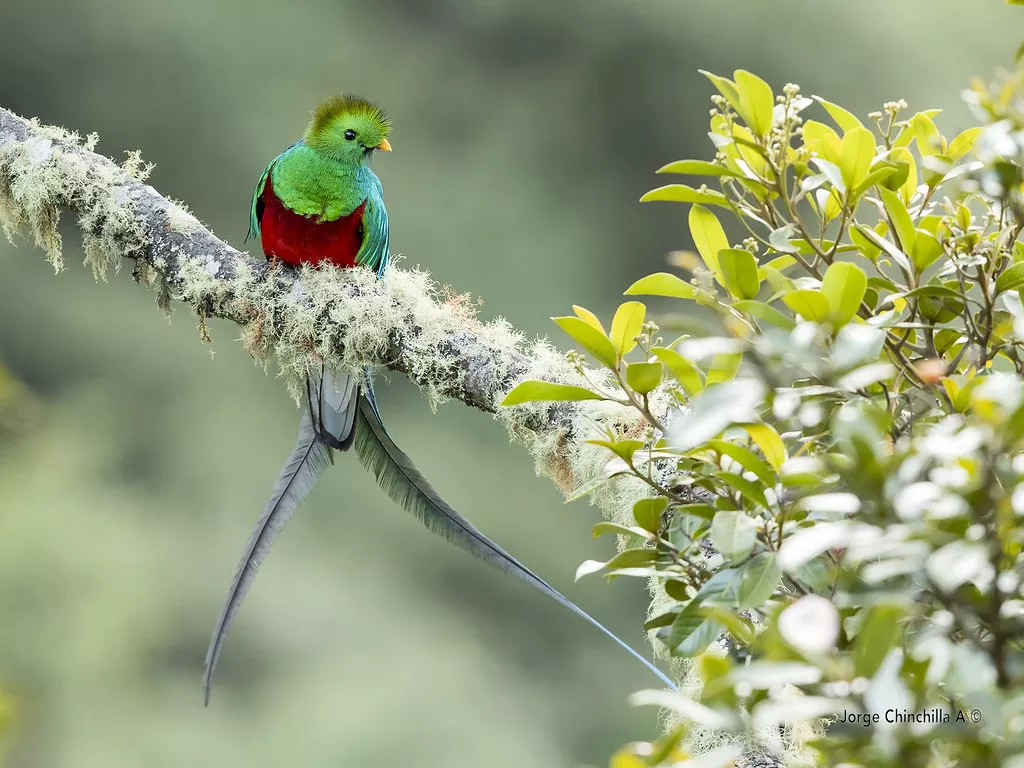
Image Source
- Scientific name: Pharomachrus mocinno
- Lifespan: 20-25 years
- Size: 36-40 centimeters (14-16 inches)
- Origin: Central America
The Resplendent Quetzal (Pharomachrus mocinno) is a stunning bird species found in the cloud forests of Central America, particularly in countries like Guatemala and Costa Rica. It is renowned for its long and vibrant tail feathers, which make it one of the most striking birds in the world. The male Resplendent Quetzal boasts tail feathers that can reach up to three feet in length, adorned with brilliant shades of green, blue, and gold. During the breeding season, the male displays its long tail feathers in courtship displays, fluttering them to attract the attention of females. The female, while lacking the long tail feathers, possesses a similar color palette but with less iridescence. The Resplendent Quetzal primarily feeds on fruits and occasionally insects and small vertebrates, contributing to the ecological diversity of its forest habitat.
Indian Peafowl:
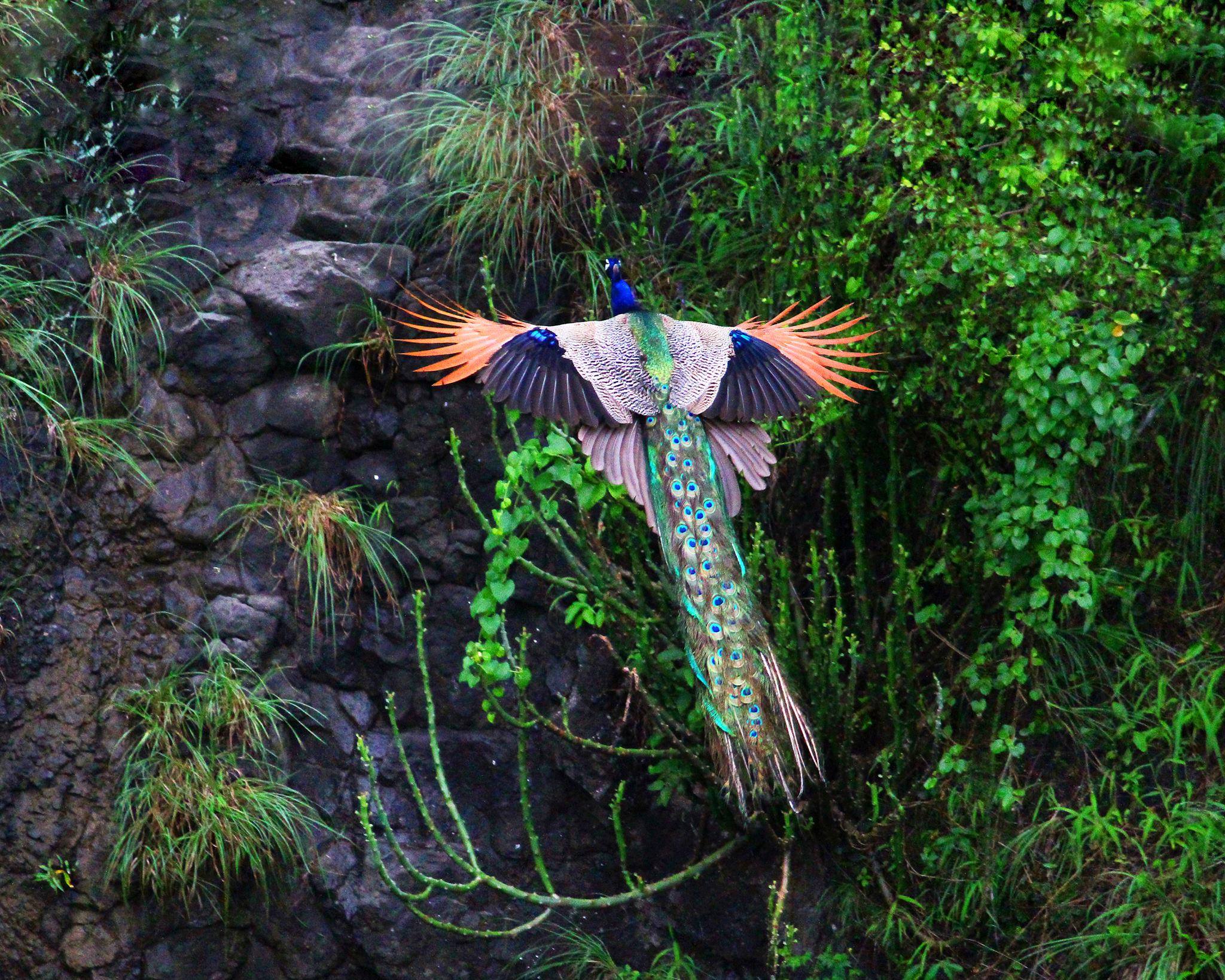
Image Source
- Scientific name: Pavo cristatus
- Lifespan: 15-20 years
- Size: 100-120 centimeters (39-47 inches)
- Origin: South Asia
The Indian Peafowl (Pavo cristatus), also known as the Peacock, is a magnificent bird native to the Indian subcontinent and Sri Lanka. It is famous for its long, extravagant tail feathers, which create a mesmerizing display during courtship rituals. The male Indian Peafowl possesses a train of elongated tail feathers, adorned with iridescent blue, green, and gold patterns. These feathers can reach up to five feet in length and are fanned out in a vibrant and eye-catching display. The female, known as the Peahen, has a more subtle appearance with shorter and less elaborate tail feathers. Indian Peafowls are omnivorous birds, feeding on a varied diet of seeds, insects, fruits, and small animals. The impressive tail feathers of the male peacock play a significant role in courtship and mating, attracting the attention of potential mates.
White-tailed Tropicbird:

Image Source
- Scientific name: Phaethon lepturus
- Lifespan: 20-25 years
- Size: 80-95 centimeters (31-37 inches)
- Origin: Tropical oceans worldwide
The White-tailed Tropicbird (Phaethon lepturus) is a graceful seabird found in tropical and subtropical regions around the world. It is known for its exceptionally long, white tail feathers that can exceed the length of its body. The bird’s overall plumage is predominantly white, with black markings on its wings and a bright yellow or orange bill. White-tailed Tropicbirds are agile fliers and spend much of their time soaring above the ocean, using their long tail feathers to steer and maneuver. They feed on fish and squid, catching their prey by diving from the air into the water. During the breeding season, they gather in colonies on remote islands or cliffs to nest and raise their young.
Greater Racket-tailed Drongo:

Image Source
- Scientific name: Dicrurus paradiseus
- Lifespan: 10-15 years
- Size: 32-37 centimeters (13-15 inches)
- Origin: Southeast Asia
The Greater Racket-tailed Drongo (Dicrurus paradiseus) is a striking passerine bird found in the forests of Southeast Asia. It is recognized for its long, deeply forked tail adorned with elongated, racket-shaped outer feathers. These distinctive feathers create a distinctive “racket” appearance, hence the bird’s name. The Greater Racket-tailed Drongo has glossy black plumage, with metallic blue-green hues visible in certain lighting conditions. It has a slender body and a slightly hooked bill. This species is known for its remarkable vocalizations, which include imitating the calls of other birds and even mimicking human sounds. The Greater Racket-tailed Drongo is an insectivorous bird and is often seen perched on tree branches or flying skillfully through the forest in search of prey.
Common Pheasant:

Image Source
- Scientific name: Phasianus colchicus
- Lifespan: 3-5 years
- Size: 60-90 centimeters (24-35 inches)
- Origin: Asia
The Common Pheasant (Phasianus colchicus) is a well-known game bird native to Asia but widely introduced around the world as a popular game species. It is a large and colorful bird, with males displaying vibrant plumage. The male pheasant has a long, sweeping tail, often held upright during courtship displays. Its body is predominantly brown with intricate patterns of colorful feathers, including metallic green, blue, and red on its head, neck, and chest. Females, on the other hand, have more subdued plumage, mainly brown with mottled patterns. Pheasants are ground-dwelling birds, foraging for seeds, grains, insects, and small invertebrates in fields, woodlands, and grasslands. They are known for their explosive takeoff and swift flight when startled.
White-throated Magpie-jay:

Image Source
- Scientific name: Calocitta formosa
- Lifespan: 15-20 years
- Size: 46-56 centimeters (18-22 inches)
- Origin: Mexico and Central America
The White-throated Magpie-jay (Calocitta formosa) is a striking bird species found in the forests and woodlands of Mexico and Central America. It is a large member of the crow family with a unique appearance. The bird has a black body, long tail, and a white throat that contrasts sharply against its dark plumage. Its head is adorned with a crest of feathers, and it has vibrant blue wings and a blue-tipped tail. White-throated Magpie-jays are highly vocal and known for their loud, raucous calls that can be heard from a distance. They are omnivorous, feeding on fruits, seeds, insects, and small vertebrates. These social birds are often seen in small groups, engaging in playful behaviors and building large communal nests.
Great Argus Pheasant:
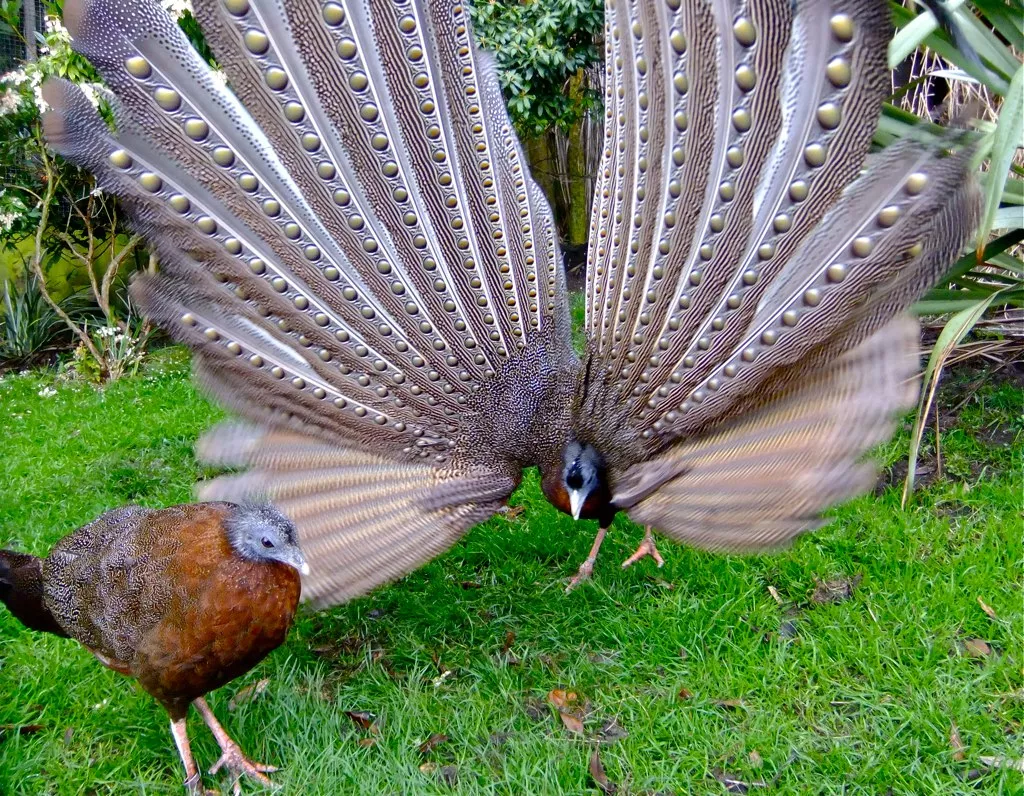
Image Source
- Scientific name: Argusianus argus
- Lifespan: 10-15 years
- Size: 140-160 centimeters (55-63 inches)
- Origin: Southeast Asia
The Great Argus Pheasant (Argusianus argus) is a large and magnificent bird species native to Southeast Asia, particularly found in the rainforests of Malaysia and Indonesia. It is renowned for its spectacular plumage and elaborate courtship display. The male Great Argus Pheasant has a dark brown body with intricate patterns of large, eye-like spots on its wings. Its most distinctive feature is the long, beautifully patterned tail adorned with dozens of elongated feathers. During courtship, the male fans out its tail feathers, creating a mesmerizing display. The female, on the other hand, has more subdued plumage with mottled brown feathers. Great Argus Pheasants are ground-dwelling birds, primarily feeding on fruits, seeds, insects, and small vertebrates.
Alexandra’s Parrot:

Image Source
- Scientific name: Polytelis alexandrae
- Lifespan: 20-30 years
- Size: 45-50 centimeters (18-20 inches)
- Origin: Australia
Alexandra’s Parrot (Polytelis alexandrae), also known as Princess Alexandra Parrot or Queen Alexandra Parrot, is a stunning bird species native to Australia. It is named after Queen Alexandra, the wife of King Edward VII of the United Kingdom. This parrot species is known for its vibrant and striking appearance. The male Alexandra’s Parrot has a predominantly green body with a bright blue face, a red band across its upper chest, and a long, elegant tail. The female has similar coloring but with less intense hues. Alexandra’s Parrots inhabit open woodlands and feed on a varied diet consisting of seeds, nuts, fruits, and flowers. They are highly social birds, often seen in small groups or pairs, and their melodious calls add to the beauty of their natural habitat.
White-bellied Go-away Bird:

Image Source
- Scientific name: Corythaixoides leucogaster
- Lifespan: 15-20 years
- Size: 48-55 centimeters (19-22 inches)
- Origin: Sub-Saharan Africa
The White-bellied Go-away Bird (Corythaixoides leucogaster) is a large bird species found in sub-Saharan Africa. It is known for its distinctive and loud vocalizations that resemble its name, “go-away.” The bird has a unique appearance with a grayish-brown body, a large head, and a long, thin crest on its crown. Its most notable feature is its white belly, which contrasts with the rest of its plumage. The White-bellied Go-away Bird feeds on fruits, leaves, flowers, and occasionally insects. It prefers living in woodland areas and savannas, where it can often be seen perched high in trees, scanning its surroundings for food and potential threats.
Fork-tailed Flycatcher:

Image Source
- Scientific name: Tyrannus savana
- Lifespan: 3-6 years
- Size: 20-25 centimeters (8-10 inches)
- Origin: South America and the Caribbean
The Fork-tailed Flycatcher (Tyrannus savana) is a striking bird species found in the Americas, particularly in parts of North and South America. It is known for its long, forked tail, which gives it a distinctive and elegant appearance. The Fork-tailed Flycatcher has a predominantly black body with white underparts and a white throat. The male has more pronounced black-and-white coloring, while the female has a more subdued grayish-brown plumage. These birds are skilled aerial hunters, catching insects on the wing using their agile flight and sharp beaks. They can be found in various habitats, including open woodlands, fields, and forest edges, often perching on exposed branches or wires to spot their prey.
Final Thoughts on Birds with Long Tails
Our journey into the world of birds with long tails has been a mesmerizing exploration of nature’s ingenuity and artistic flair. These remarkable creatures have captivated us with their graceful flight and stunning displays. From the effortless glide of the Swallow-tailed Kite to the elaborate courtship dances of the Birds of Paradise, their long tails have become a symbol of elegance and beauty. These avian wonders have evolved their extraordinary plumage to navigate the skies, attract mates, and establish their presence in the avian kingdom. As we conclude our adventure, let us carry the awe-inspiring images of these birds in flight, their long tails trailing behind them, reminding us of the remarkable diversity and splendor found in the natural world. May their majestic displays continue to inspire us to appreciate and protect the fragile balance of our precious ecosystems.
FAQs on Birds with Long Tails
Which bird species are known for having long tails?
Several bird species are known for their long tails, including the Asian Paradise Flycatcher, Peacock, Swallow-tailed Kite, Birds of Paradise, Lyrebird, and Pheasants.
What is the purpose of a bird’s long tail?
The long tail of a bird serves various purposes. It can aid in maneuverability during flight, assist in balance while perched or foraging, and play a role in courtship displays and attracting mates.
How do birds with long tails fly without any issues?
Birds with long tails have adaptations that allow them to fly with ease. They have strong flight muscles and tail feathers that are lightweight and flexible, enabling them to control their movements and maintain stability during flight.
Can birds with long tails face any challenges or disadvantages?
While long tails provide benefits, they can also pose challenges to birds. Long-tailed birds may be more vulnerable to predation as their tails can make them more noticeable to predators. Additionally, navigating through dense vegetation or confined spaces may be more challenging for birds with long tails.
Are there any other bird adaptations associated with long tails?
Birds with long tails may have other adaptations, such as specialized feathers or behaviors, that enhance their flight capabilities. Some species may possess elongated tail streamers, while others use their tails for aerial acrobatics or elaborate courtship displays, showcasing their agility and genetic fitness.
List of Birds with Long Tails
- Long-tailed Widowbirds
- Ribbon-tailed Astrapia
- Wilson’s Bird-of-Paradise
- Greater Bird-of-Paradise
- Red-billed Streamertail
- Lady Amherst’s Pheasant
- Superb Lyrebird
- Asian Paradise Flycatcher
- Resplendent Quetzal
- Indian Peafowl
- White-tailed Tropicbird
- Greater Racket-tailed Drongo
- Common Pheasant
- White-throated Magpie-Jay
- Great Argus Pheasant
- Alexandra’s Parrot
- White-bellied Go-Away Bird
- Fork-tailed Flycatcher


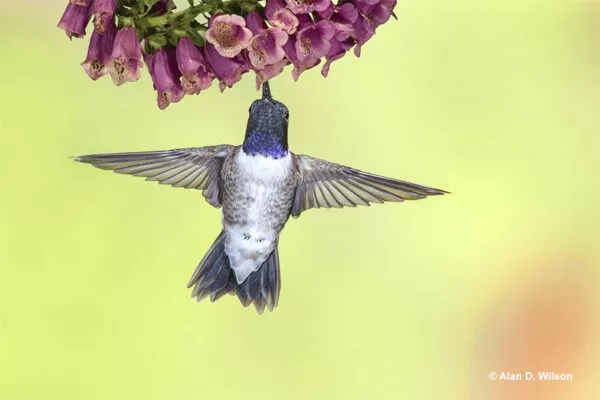

![35 Most Beautiful Birds in the World [Pretty Birds]](https://birdsology.com/wp-content/uploads/2023/05/27413009815_b8357b0f0e_b-600x400.jpg.webp)
